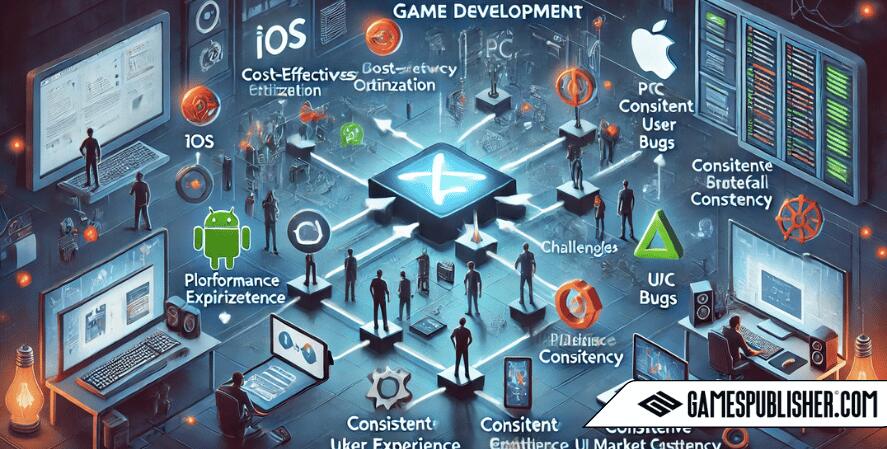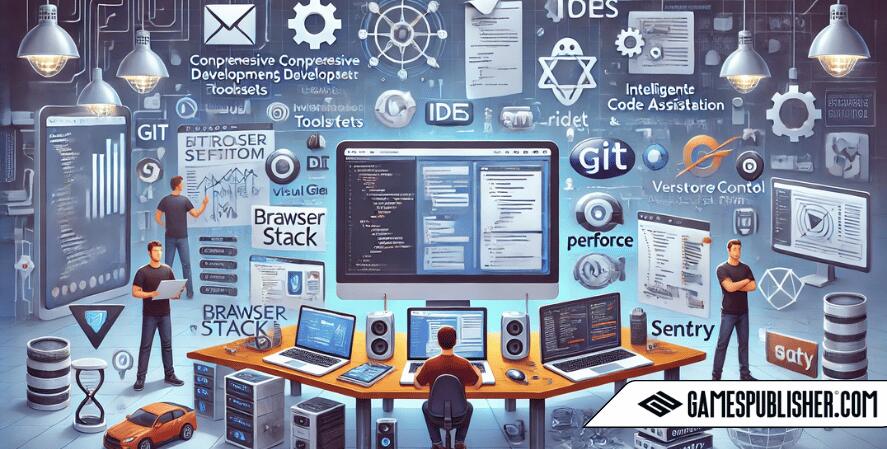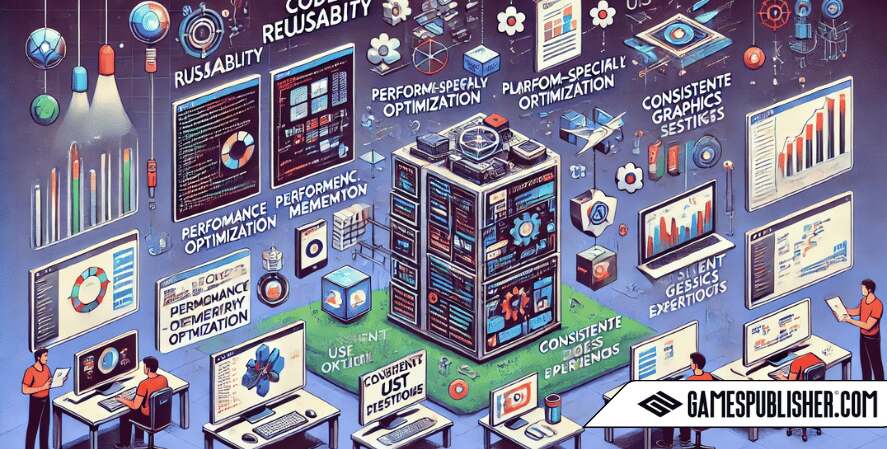Welcome to the world of cross-platform game development! In today’s gaming industry, creating games that work seamlessly across multiple platforms is crucial. This approach helps developers reach a wider audience, increase revenue, and enhance the user experience.
About Gamespublisher.com
Gamespublisher.com is a top resource for game development and publishing insights. They provide valuable information for both new and experienced developers.
Importance of Cross-Platform Game Development
Cross-platform game development means creating games that can run on various devices and operating systems with minimal modifications. This method brings many benefits:
- Reach a Wider Audience: By supporting multiple platforms, your game can attract more players.
- Increase Revenue Potential: More players often mean more sales and higher profits.
- Enhance User Experience: Consistency across platforms ensures that players enjoy a smooth experience no matter the device.
Relation to Game Development and Publishing
Using the right tools and frameworks for cross-platform development can streamline the game creation process and improve the quality of the final product.
Overview of Cross-Platform Game Development

Definition and Benefits
Cross-platform game development allows a game to run on different platforms like iOS, Android, PC, and consoles with minimal changes. Benefits include:
- Cost-Effective: Develop once and deploy everywhere.
- Consistent User Experience: Ensures players have a similar experience regardless of the device.
- Broad Market Reach: Increases the number of potential players.
Challenges
Developing cross-platform games comes with challenges such as:
- Performance Optimization: Ensuring smooth performance on various devices.
- Platform-Specific Bugs: Different platforms can introduce unique issues.
- UI/UX Consistency: Maintaining a consistent look and feel across platforms.
Popular Cross-Platform Game Development Frameworks

Unity
Features
- Asset Store: A marketplace for assets and tools.
- Scripting: Uses C# for scripting.
- Graphics: Supports both 2D and 3D graphics.
Supported Platforms
Pros and Cons
Pros:
- Extensive community support.
- Rich asset store.
- Versatile for different types of games.
Cons:
- Resource-intensive.
- Steeper learning curve for beginners.
Unreal Engine
Features
- High-Fidelity Graphics: For realistic visuals.
- Blueprints Visual Scripting: Create game logic without coding.
- Marketplace: Access to various assets and plugins.
Supported Platforms
- iOS, Android, PC, consoles, WebGL, VR/AR devices.
Pros and Cons
Pros:
- Superior graphics.
- Visual scripting is user-friendly.
- Comprehensive documentation.
Cons:
- High system requirements.
- Overkill for simple games.
Godot
Features
- Scene System: Simplifies game structure.
- GDScript: Easy-to-learn scripting language.
- Open-Source: Free and community-driven.
Supported Platforms
- iOS, Android, PC, Web (HTML5), consoles.
Pros and Cons
Pros:
- Lightweight.
- Free and open-source.
- Easy to learn.
Cons:
- Smaller community.
- Fewer built-in assets.
Cocos2d-x
Features
- Lightweight Framework: Ideal for mobile games.
- C++ Support: For performance-optimized code.
- Flexibility: Highly customizable.
Supported Platforms
- iOS, Android, PC, Web (HTML5), consoles.
Pros and Cons
Pros:
- Lightweight.
- Free and open-source.
- Strong for 2D games.
Cons:
- Steeper learning curve.
- Smaller community.
Essential Tools for Cross-Platform Development

Integrated Development Environments (IDEs)
- Features: Comprehensive toolset, debugging, and testing.
- Benefits: Extensive extensions and plugins.
- Features: Intelligent code assistance and refactoring tools.
- Benefits: Cross-platform support on Windows, macOS, and Linux.
Version Control Systems
- Importance: Manages code changes efficiently.
- Benefits: Supports branching and merging.
- Importance: Ideal for larger projects.
- Benefits: Scalable and collaborative features.
Testing and Debugging Tools
- Use: Tests across different devices and browsers.
- Benefits: Real device testing for accurate results.
- Use: Real-time error tracking and debugging.
- Benefits: Detailed error reports for effective debugging.
Best Practices for Cross-Platform Game Development

Code Reusability
Modular Code
Writing reusable and modular code saves time and effort. It ensures consistency and simplifies updates.
Platform-Specific Optimization
Performance Tuning
Optimize performance by:
- Efficient memory management.
- Tailoring graphics settings for each platform.
Consistent User Experience
UI/UX Design
Ensure a consistent user interface and experience by:
- Designing adaptive layouts.
- Implementing intuitive controls.
Testing Across Platforms
Automated Testing
Use automated tests to cover various platforms efficiently.
Manual Testing
Manual testing is crucial for identifying platform-specific issues.
Case Studies and Examples
Successful Cross-Platform Games
Fortnite exemplifies a successful cross-platform game. Key strategies include:
- Consistent Updates: Keeps all versions in sync.
- Cross-Platform Play: Allows players on different platforms to play together.
Genshin Impact is known for its impressive graphics and gameplay. Key strategies include:
- Unified Development: A single codebase for consistency.
- Optimization: Ensures smooth performance on various devices.
Lessons Learned
Challenges Faced
- Performance Bottlenecks: Ensuring optimal performance.
- Bug Fixing: Addressing platform-specific issues.
Solutions Implemented
- Custom Optimization: Tailored techniques for each platform.
- Extensive Testing: Rigorous testing processes.
Conclusion
Recap of Key Points
Cross-platform game development offers many benefits, such as a wider audience reach, increased revenue, and enhanced user experience. Challenges include performance optimization and UI/UX consistency. Using the right tools and frameworks, like Unity, Unreal Engine, Godot, and Cocos2d-x, can make the development process smoother.
Future of Cross-Platform Game Development
The future looks bright with innovations in cloud gaming, AI-driven development tools, and more sophisticated frameworks set to revolutionize the industry.
Loading survey...

